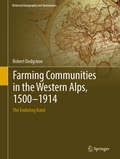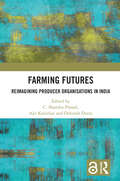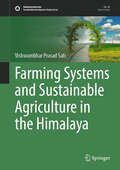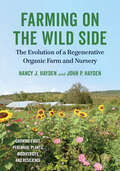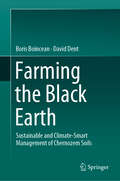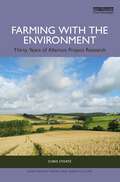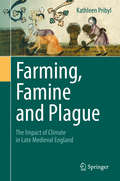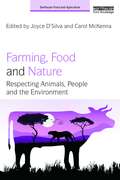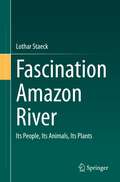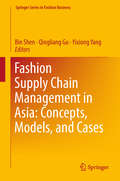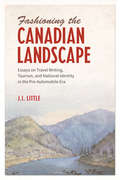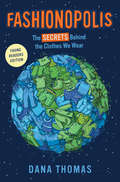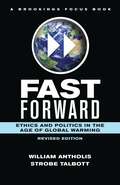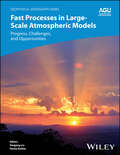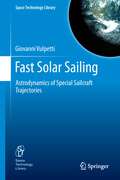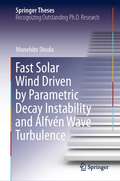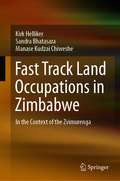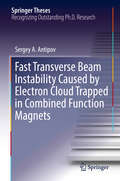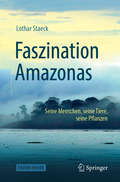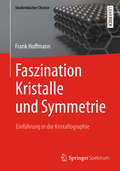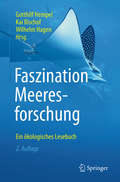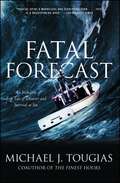- Table View
- List View
Farming Communities in the Western Alps, 1500–1914: The Enduring Bond (Historical Geography and Geosciences)
by Robert DodgshonThis monograph explores traditional farming communities in French-speaking areas of the western Alps for the period 1500-1914 and how they endured in such an environment despite the many problems and risks which it posed for their subsistence and welfare. Using an extensive amount of archival material drawn from the relevant regional archives, the book presents a great deal of fresh data. Its central theme is how such communities responded to the opportunities and challenges presented by the highly variegated environment of their setting. The view taken is that their strategies of exploitation stressed diversity and flexibility, mapping the highly varied ecologies and resource opportunities of their setting into these strategies by spreading livelihood and risk as widely as possible. This interpretative framework is developed across all the book's themes: landholding, arable and livestock sectors, use of the commons and, finally, how communities coped with climate-based risks.The book appeals to geographers, historians, environmental scientists and everyone interested in traditional farming communities and their long-term challenges.
Farming Futures: Reimagining Producer Organisations in India
by C. Shambu Prasad Ajit Kanitkar Deborah DuttaThis book studies the management challenges and possibilities in sustaining farmer producer organisations (FPOs). It goes beyond the conventional metrics of cost-benefit analysis by drawing on 15 case studies of diverse FPOs spread across India to fill a significant knowledge-practice gap in the domain of producer collectives. The book explores issues of ownership and governance, studies the empirical basis for policy decisions on FPOs, and provides actionable insights and knowledge, keeping in mind the complexity of the institutional design of an FPO. It also discusses the envisioned role of civil society organisations in supporting FPOs and looks at the kind of institutional innovations that are needed to create a cohesive ecosystem for FPOs. A unique collaborative project jointly authored by academics and development practitioners, the book will be of use to students and researchers of agricultural economics, environment and business, agricultural development, environmental economics, rural studies, entrepreneurship, and South Asian studies. It will also be of interest to development professionals, civil society organisations, and policymakers.
Farming Systems and Sustainable Agriculture in the Himalaya (Sustainable Development Goals Series)
by Vishwambhar Prasad SatiThe farming system in the Central Himalayan Region is distinctive and unique, mainly focusing on the cultivation of traditional subsistence cereal crops. The agrobiodiversity in this region is rich, with the Central Himalaya growing numerous cultivars and crop races. The practice of cultivating many crops or cultivars in a single field is known as the 'Barahnaja System.' Another peculiar system is the Sar/Sari system, where different crops grow in the two Sars during the same seasons, with one Sar left fallow for six months while the other grows crops. This century-old farming method involves plowing fields with oxen and using organic manure to enhance crop production and productivity. However, recent changes have been observed in the farming systems. The area under traditionally growing millets is declining. In river valleys and middle altitudes, there is a recent trend towards cultivating paddy and wheat. Unfortunately, the cultivation of temperate fruits – apple and citrus has seen a decline in terms of area, production, and productivity. Various factors are influ encing farming systems in the Central Himalaya, such as high climate variability and change, decreasing crop production and productivity, evolving food habits, and out-migration. The book contains 12 chapters illustrating introduction, land use and land cover change, cropping patterns, crop diversity and agro-ecological zones, farming systems and sustainable agriculture, climate change and its impact on agriculture, infrastructural facilities for sustainable agriculture, declining agriculture: a case study, crop productivity and suitability analyzes, agribusiness, policies and planning for sustainable agriculture, and conclusions. It serves as a valuable resource for students, academicians, researchers, policymakers, and farmers.
Farming on the Wild Side: The Evolution of a Regenerative Organic Farm and Nursery
by Nancy J. Hayden John P. HaydenOne farm&’s decades-long journey into regenerative agriculture—and how these methods enhance biodiversity, pollinators, and soil healthNorthern Vermont&’s Nancy and John Hayden have spent the last 25 years transforming their draft horse–powered, organic vegetable and livestock operation into an agroecological, regenerative, biodiverse, organic fruit farm, fruit nursery, and pollinator sanctuary. In Farming on the Wild Side they explain the philosophical and scientific principles that influenced them as they phased out sheep and potatoes and embraced apples, pears, stone fruits, and a wide variety of uncommon berry crops; turned much of their property into a semi-wild state; and adapted their marketing and sales strategies to the new century. As the Haydens pursued their goals of enhancing biodiversity and regenerating their land, they incorporated agroforestry and permaculture principles into perennial fruit polycultures, a pollinator sanctuary, repurposed greenhouses for growing fruit, hügelkultur, and ecological &“pest&” management. Beyond the practical techniques and tips, this book also inspires readers to develop greater ecological literacy and respect for the mysteries of the global ecosystem. Farming on the Wild Side tells a story about new ways to manage small farms and homesteads, about nurturing land, about ecology, about economics, and about things that we can all do to heal both the land and ourselves.
Farming the Black Earth: Sustainable and Climate-Smart Management of Chernozem Soils (International Year Of Planet Earth Ser.)
by David Dent Boris Boincean'This book deals with the sustainability of agriculture on the Black Earth by drawing on data from long-term field experiments. It emphasises the opportunities for greater food and water security at local and regional levels.The Black Earth, Chernozem in Russian, is the best arable soil in the world and the breadbasket of Europe and North America. It was the focus of scientific study at the very beginnings of soil science in the late 19th century—as a world in itself, created by the roots of the steppe grasses building a water-stable granular structure that holds plentiful water, allows rapid infiltration of rain and snow melt, and free drainage of any surplus.Under the onslaught of industrial farming, Chernozem have undergone profound but largely unnoticed changes with far-reaching consequences—to the point that agriculture on Chernozem is no longer sustainable. The effects of agricultural practices on global warming, the diversion of rainfall away from replenishment of water resources to destructive runoff, and the pollution of streams and groundwater are all pressing issues. Sustainability absolutely requires that these consequences be arrested.
Farming with the Environment: Thirty Years of Allerton Project Research (Earthscan Food and Agriculture)
by Chris StoateThis book examines, discusses and shares over 30 years’ worth of research from the Allerton Project, a research and demonstration farm in the UK which has been carrying out applied interdisciplinary research to explore and explain the need to adapt the management of farmland for environmental protection and to provide public benefits. Designed to provide guidance, feedback and recommendations to farmers, practitioners and policymakers, the Allerton Project is an exceptionally well-documented case study of lowland agricultural land management which has the purpose of meeting multiple objectives. This book draws on the wealth of knowledge built over the past 30 years and unveils and clarifies the complexity of a number of topical debates about current land and wildlife management at a range of spatial scales, explores the underlying historical context and provides some important pointers to future directions of travel. Topics include soil health and management, farmland ecology, development of management practices to enhance biodiversity, natural flood management, water quality and aquatic ecology. Most importantly, the book demonstrates how the findings from this project relate to agricultural and conservation policy more broadly as well as how they are applicable to similar projects throughout Europe. This book will be of great interest to professionals working in agricultural land management and conservation, as well as researchers and students of agri-environmental studies and agricultural policy.
Farming, Famine and Plague
by Kathleen PribylThis book is situated at the cross-roads of environmental, agricultural and economic history and climate science. It investigates the climatic background for the two most significant risk factors for life in the crisis-prone England of the Later Middle Ages: subsistence crisis and plague. Based on documentary data from eastern England, the late medieval growing season temperature is reconstructed and the late summer precipitation of that period indexed. Using these data, and drawing together various other regional (proxy) data and a wide variety of contemporary documentary sources, the impact of climatic variability and extremes on agriculture, society and health are assessed. Vulnerability and resilience changed over time: before the population loss in the Great Pestilence in the mid-fourteenth century meteorological factors contributing to subsistence crises were the main threat to the English people, after the arrival of Yersinia pestis it was the weather conditions that faciliated the formation of recurrent major plague outbreaks. Agriculture and harvest success in late medieval England were inextricably linked to both short term weather extremes and longer term climatic fluctuations. In this respect the climatic transition period in the Late Middle Ages (c. 1250-1450) is particularly important since the broadly favourable conditions for grain cultivation during the Medieval Climate Optimum gave way to the Little Ice Age, when agriculture was faced with many more challenges; the fourteenth century in particular was marked by high levels of climatic variability.
Farming, Food and Nature: Respecting Animals, People and the Environment (Earthscan Food and Agriculture)
by Joyce D'Silva Carol McKennaLivestock production and its use of finite resources is devastating biodiversity and pushing wildlife to the brink of extinction. This powerful book examines the massive global impact caused by intensive livestock production and then explores solutions, ranging from moving to agroecological farming to reducing consumption of animal products, including examples of best practice and innovation, both on land and within the investment and food industries. Leading international contributors spell out the problems in terms of planetary limits, climate change, resources, the massive use of cereals and soy for animal feed, and the direct impact of industrial farming on the welfare of farmed animals. They call for an urgent move to a flourishing food system for the sake of animals, the planet and us. Some offer examples of global good practice in farming or the power of the investment community to drive change, and others highlight food business innovation and exciting developments in protein diversification. Providing a highly accessible overview of key issues, this book creates a timely resource for all concerned about the environmental, social and ethical issues facing food, farming and nature. It will be an invaluable resource and provide inspiration for students, professionals, non-governmental organisations (NGOs) and the general reader.
Fascinating Shells: An Introduction to 121 of the World’s Most Wonderful Mollusks
by Andreia SalvadorA New Scientist Best Book of the Year Beautiful photographs of stunning shells from London's Natural History Museum, home to one of the most significant and comprehensive collections in the world. Collected and treasured for their beauty, used in religious rituals, or even traded as currency, shells have fascinated humans for millennia. Ancient and enchanting, dazzling in form and variety, these beautiful objects come from mollusks, one of the most diverse groups in the animal kingdom, including snails, oysters, cuttlefish, and chitons. Soft-bodied, these creatures rely on shells for protection from enemies and their environments, from snowy mountains to arid deserts, in deep-sea hydrothermal vents and the jungles of the tropics, on rocky shores, and in coral reefs. In this book, mollusk expert Andreia Salvador profiles some of the world’s most beautiful and quirky shells, each selected from the more than eight million specimens held in the collection at London’s Natural History Museum. We lock eyes with the hundred-eyed cowry, named after "the all-seeing one," the giant Argus Panoptes of Greek mythology. We see how shells' appearances translate into defense strategies, as with the zigzag nerite, which varies its patterning to deceive and confuse predators. And we meet shell inhabitants, such as the amber snail, which eats earthworms by sucking them up like spaghetti. Reproduced in full color and striking detail, these shells have much to reveal about the history of collecting, the science of taxonomy, and the human desire to understand the natural world.
Fascination Amazon River: Its People, Its Animals, Its Plants
by Lothar StaeckIn this volume, the Amazon and its adjacent rainforest are presented in all their important facets: First, there is the vast river system itself, with its network of white, black, and clear water rivers. The different water qualities have an enormous impact on people, animals and plants. On the other hand, the people who live along this "Rio Mar," the ocean river, are described. They are the Caboclos, the descendants of the European immigrants and the indigenous people, and it is the different indigenous peoples who have mostly settled along the riverbanks, since the rivers here replace the roads and make contact with other people possible in the first place. Although these ethnic groups have been in contact with Western civilization for generations,they have surprisingly preserved a number of remarkable traditions that are described here. The treasure of the Amazon is its plants and animals. Therefore, the most fascinating flowering plants, including numerous medicinal plants, trees, epiphytes and lianas from different habitats are described in detail and illustrated with excellent photographs. Finally, it is the animals, especially in and around the river, that have always fascinated Alexander von Humboldt. Not only is the lifestyle of the legendary pink dolphins, piranhas and tarantulas explained here, but the impressive amphibians, reptiles and mammals of the jungle are also discussed.epiphytes and lianas from different habitats are described in detail and illustrated with excellent photographs. Finally, it is the animals, especially in and around the river, that have always fascinated Alexander von Humboldt. Not only is the lifestyle of the legendary pink dolphins, piranhas and tarantulas explained here, but the impressive amphibians, reptiles and mammals of the jungle are also discussed.epiphytes and lianas from different habitats are described in detail and illustrated with excellent photographs. Finally, it is the animals, especially in and around the river, that have always fascinated Alexander von Humboldt. Not only is the lifestyle of the legendary pink dolphins, piranhas and tarantulas explained here, but the impressive amphibians, reptiles and mammals of the jungle are also discussed.This book is a translation of the original German 1st edition Faszination Amazonas by Lothar Staeck, published by Springer-Verlag GmbH Germany, part of Springer Nature in 2019. The translation was done with the help of artificial intelligence (machine translation by the service DeepL.com). A subsequent human revision was done primarily in terms of content, so that the book will read stylistically differently from a conventional translation. Springer Nature works continuously to further the development of tools for the production of books and on the related technologies to support the authors.
Fashion Forward: Striving for Sustainable Style (Orca Footprints #22)
by Raina DelisleFashion can be fun, but it can also hurt people, animals and the planet. Fashion Forward: Striving for Sustainable Style goes behind the glitz and glamour to explore the social and environmental issues within the fashion industry. It looks at the history of fashion, from why humans started wearing clothes to the birth of consumerism to the explosion of fast fashion and fashion’s footprint. The book introduces readers to the innovative people, companies and organizations that are taking positive action on fashion. Kids will discover how to make ethical choices and become fashion heroes for the future. There are easy ways we can help transform the fashion industry and still look stylish at the same time! The epub edition of this title is fully accessible.
Fashion Supply Chain Management in Asia: Concepts, Models, and Cases (Springer Series in Fashion Business)
by Bin Shen Qingliang Gu Yixiong YangThis book serves as a comprehensive guide to understanding the theories and applications in managing the Asian fashion supply chain, presenting both quantitative and exploratory studies. Providing academicians and practitioners insights into the latest developments and models, it also offers diverse perspectives on areas like strategic sourcing, quick response strategies, and other essential parts of the supply chain.
Fashion in 21st Century China: Design, Education, and Business (Springer Series in Fashion Business)
by Yuli Bai Yingchun ZangThis book explores the dynamic landscape of fashion in China since the beginning of the 21st century through an integrated perspective. The book considers key questions related to the changes in China’s fashion dynamics driven largely by the shifts in the mindset of Chinese consumers due to the current sociocultural contexts. To provide an understanding of these important shifts, this three-part monograph pays close attention to the new generation of Chinese fashion designers and consumers. The book explores in detail related topics such as, how today’s Chinese consumers relate to foreign brands, the meaning of apparel brands as identity symbols or cultural signs to contemporary young consumers, the attractiveness of Western fashion designers and brands in the eyes of current Chinese consumers as compared to past consumers, and how brands could adapt to the online-centered consumption behavior. The book serves as an insightful update on the Chinese fashion landscape for researchers, practitioners and passionate followers of its evolution.
Fashioning the Canadian Landscape: Essays on Travel Writing, Tourism, and National Identity in the Pre-Automobile Era
by John Irvine LittleInterpretations of Canada's emerging identity have been largely based on a relatively small corpus of literary writing and landscape paintings, overlooking the influence of the British and American travel writers who published hundreds of books and articles that did much to fix the image of Canada in the popular imagination. In his Fashioning the Canadian Landscape, J.I. Little examines how Canada, much like the United States, came to be identified with its natural landscape. Little argues that in contrast to the American identification with the wilderness sublime, however, Canada’s image was strongly influenced by the picturesque convention favoured by British travel writers. This amply illustrated volume includes chapters ranging from Labrador to British Columbia, some of which focus on such notable British authors as Rupert Brooke and Rudyard Kipling, and others on talented American writers such as Charles Dudley Warner. Based not only on the views of the landscape but on the racist descriptions of the Indigenous peoples and the romanticization of the Canadian ‘folk’, Little argues that the national image that emerged was colonialist as well as colonial in nature.
Fashionopolis (Young Readers Edition): The Secrets Behind the Clothes We Wear
by Dana ThomasA look at fast fashion and its impact on the environment and social justice, perfect for middle grade classroomsDid you ever think about where your jeans come from? How about the people who made your T-shirt, or what happens to the clothes you grow out of when you're done wearing them? The fabrics clothes are made of, the way they are designed and sewn and shipped around the world, and the way we consume them and get rid of them--every step in this process has a big impact on our environment, on the people who work in clothing factories, and on our cultures. This nonfiction book shows us how the clothes we wear--and throw away--every day are made, and what that means for our planet and for people around the world.
Fast Forward
by Strobe Talbott William AntholisFast Forward is equal parts science primer, history lesson, policy prescription, and ethical treatise. This pithy and compelling book makes clear what we know and don't know about global warming; why the threat demands prudent and urgent action; why the transition to a low-carbon economy will be the most difficult political and economic transaction in history; and how it requires nothing less than a revolution in our sense of civic responsibility. William Antholis and Strobe Talbott guide the reader through two decades of climate change politics and diplomacy, explaining the national and international factors that have influenced and often impeded domestic climate legislation and global negotiations. Recent United Nations-sponsored summits have demonstrated that the world cannot wait for a binding global treaty. Instead, the authors believe that the "Big Four" of America, the European Union, China, and India must lead the way forward. They recommend a new international mechanism modeled on the General Agreement on Tariffs and Trade that would monitor national commitments and create incentives for other countries to coordinate their efforts to cut emissions.Antholis and Talbott put their recommendations for legislative and diplomatic action into the larger context of our obligation to future generations, echoing a theme stressed by a diverse coalition of religious leaders calling for ambitious action on climate change. The world we leave to our children and grandchildren is not an abstraction, or even just a legacy; we must think about what kind of world that will be in deciding how we live-and act-today.
Fast Processes in Large-Scale Atmospheric Models: Progress, Challenges, and Opportunities (Geophysical Monograph Series #282)
by Leo J. DonnerImproving weather and climate prediction with better representation of fast processes in atmospheric models Many atmospheric processes that influence Earth’s weather and climate occur at spatiotemporal scales that are too small to be resolved in large scale models. They must be parameterized, which means approximately representing them by variables that can be resolved by model grids. Fast Processes in Large-Scale Atmospheric Models: Progress, Challenges and Opportunities explores ways to better investigate and represent multiple parameterized processes in models and thus improve their ability to make accurate climate and weather predictions. Volume highlights include: Historical development of the parameterization of fast processes in numerical models Different types of major sub-grid processes and their parameterizations Efforts to unify the treatment of individual processes and their interactions Top-down versus bottom-up approaches across multiple scales Measurement techniques, observational studies, and frameworks for model evaluation Emerging challenges, new opportunities, and future research directions The American Geophysical Union promotes discovery in Earth and space science for the benefit of humanity. Its publications disseminate scientific knowledge and provide resources for researchers, students, and professionals.
Fast Solar Sailing
by Giovanni VulpettiThe range of solar sailing is very vast; it is a fully in-space means of propulsion that should allow us to accomplish various mission classes that are literally impossible using rocket propulsion, no matter if nuclear or electric. Fast and very fast solar sailings are special classes of sailcraft missions, initially developed only in the first half of the 1990s and still evolving, especially after the latest advances in nanotechnology. This book describes how to plan, compute and optimize the trajectories of sailcraft with speeds considerably higher than 100 km/s; such sailcraft would be able to explore the outer heliosphere, the near interstellar medium and the solar gravitational lens (550-800 astronomical units) in times significantly shorter than the span of an average career (~ 35 years), just to cite a few examples. The scientific interest in this type of exploration is huge.
Fast Solar Wind Driven by Parametric Decay Instability and Alfvén Wave Turbulence (Springer Theses)
by Munehito ShodaThis book discusses key theoretical aspects concerning the formation of the solar wind: the most essential building block in the heliosphere, in which planets orbit. To understand the influence of solar activity on planetary magnetospheres and atmospheres, we need to first understand the origin of the solar wind, which is still under debate. This book presents the outcomes of state-of-the-art numerical simulations of solar wind acceleration, including the first three-dimensional simulation of the turbulence-driven solar wind model. One of the book’s goals is to include compressional effects in the dynamics of solar wind turbulence; accordingly, it discusses parametric decay instability in detail. Several key aspects that are relevant to the Parker Solar Probe observations are also discussed. Given its scope, the book plays a key role in bridging the gap between the theory of magnetohydrodynamic turbulence and current/future in-situ observations of the solar wind. This book is based on the Ph.D. thesis by the author, which won the 2019 International Astronomical Union Division E Ph.D. prize.
Fast Track Land Occupations in Zimbabwe: In the Context of the Zvimurenga
by Kirk Helliker Manase Kudzai Chiweshe Sandra BhatasaraThis book offers the first detailed scholarly examination of the nation-wide land occupations which spread across the Zimbabwean countryside from the year 2000, and led to the state’s fast track land reform programme. In an innovative way, it highlights the decentralized character of the occupations by recognizing significant spatial variation around a number of key themes, including historical memory, modes of mobilization and gender. A case study of the land occupations in Mashonaland Central Province, based on original research, adds empirical weight to the argument. In further identifying and understanding the specificities and complexities of the land occupations, the book also frames them by way of a nuanced comparative-historical analysis of the three zvimurenga. It thus examines the land occupations (referred to, likely controversially, as the ‘third chimurenga’) with reference to the original anti-colonial revolt from the 1890s (the first chimurenga) and the war of liberation in the 1970s (the second chimurenga). Further, the book engages critically with the ruling party’s chimurenga narrative and the hegemonic understanding of the land occupations within Zimbabwean studies. This book is a crucial read for all scholars and students of post-2000 land and politics in Zimbabwe, but also for those more broadly interested in historical-comparative analyses of land struggles in Zimbabwe and beyond.
Fast Transverse Beam Instability Caused by Electron Cloud Trapped in Combined Function Magnets (Springer Theses)
by Sergey A. AntipovThis thesis presents profound insights into the origins and dynamics of beam instabilities using both experimental observations and numerical simulations. When the Recycler Ring, a high-intensity proton beam accelerator at Fermi National Accelerator Laboratory, was commissioned, it became evident that the Recycler beam experiences a very fast instability of unknown nature. This instability was so fast that the existing dampers were ineffective at suppressing it. The nature of this phenomenon, alongside several other poorly understood features of the beam, became one of the biggest puzzles in the accelerator community. The author investigated a hypothesis that the instability arises from an interaction with a dense cloud of electrons accompanying the proton beam. He studied the phenomena experimentally by comparing the dynamics of stable and unstable beams, by numerically simulating the build-up of the electron cloud and its interaction with the beam, and by constructing an analytical model of an electron cloud-driven instability with the electrons trapped in combined-function dipole magnets. He has devised a method to stabilize the beam by a clearing bunch, which conclusively revealed that the instability is caused by the electron cloud, trapped in a strong magnetic field. Finally, he conducted measurements of the microwave propagation through a single dipole magnet. These measurements have confirmed the presence of the electron cloud in combined-function magnets.
Faszination Amazonas: Seine Menschen, seine Tiere, seine Pflanzen
by Lothar StaeckIn diesem Band wird der Amazonas und sein angrenzender Regenwald in allen wichtigen Facetten dargestellt: Zum einen ist es das riesige Flusssystem selbst mit seinem Geflecht aus Weiß-, Schwarz- und Klarwasserflüssen. Aus den unterschiedlichen Wasserqualitäten resultieren enorme Auswirkungen auf Menschen, Tiere und Pflanzen. Zum anderen werden die Menschen beschrieben, die an diesem "Rio Mar", dem Meeres-Fluss, leben. Es sind die Caboclos, die Nachfahren der europäischen Einwanderer und der Urbevölkerung, und es sind die unterschiedlichen indigenen Völker, die sich meist an den Flussufern niedergelassen haben, da die Flüsse hier die Straßen ersetzen und überhaupt erst einen Kontakt zu anderen Menschen ermöglichen. Diese Volksgruppen sind zwar seit Generationen mit der westlichen Zivilisation in Kontakt, doch sie haben überraschenderweise auch heute noch eine Reihe bemerkenswerter Traditionen bewahrt, die hier beschrieben werden. Der Schatz der Amazonasregion sind seine Pflanzen und Tiere. Deshalb werden ausführlich die faszinierendsten Blütenpflanzen, darunter zahlreiche Heilpflanzen, Bäume, Epiphyten und Lianen unterschiedlicher Lebensräume beschrieben und mit hervorragenden Fotos illustriert. Schließlich sind es die Tiere, vor allem im und am Fluss, aber auch im angrenzenden Regenwald, die uns Europäer seit Alexander von Humboldt schon immer fasziniert haben. Hier wird nicht nur die Lebensweise der legendären Rosa-Delfine, Piranhas und Vogelspinnen erläutert, sondern auch auf eindrucksvolle Amphibien, Reptilien und Säugetiere des Urwaldes eingegangen.
Faszination Kristalle und Symmetrie: Einführung in die Kristallographie (Studienbücher Chemie)
by Frank HoffmannDieses Buch lädt Sie zu einer systematischen Rundreise durch die faszinierende Welt der Kristalle und ihrer Symmetrien ein. Sie werden mit der Symmetrie äußerer Kristallformen (Morphologie) ebenso vertraut gemacht wie mit ihrer inneren Struktur und lernen sämtliche Symmetrieelemente kennen, die zu Klassifizierung und Beschreibung von Kristallstrukturen benötigt werden. Das Buch erklärt die Zusammenhänge auf eine sehr anschauliche, nicht-mathematische Art und Weise und besticht durch klare, hochwertige Abbildungen. Online-Materialien begleiten das Buch; so unterstützen 3D-Modelle, die Sie am Bildschirm erkunden können, das räumliche Verständnis des Aufbaus von Kristallen.Nach der Lektüre des Werkes werden Sie nicht nur wissen, was eine Raumgruppe ist und wie die Internationalen Tabellen für Kristallographie zu lesen sind, sondern auch kristallographische Spezifikationen in Fachpublikationen deuten können. Und wenn Sie wirklich etwas nicht verstehen, haben Sie Gelegenheit, auf der Website zum Buch dem Autor Fragen zu stellen.
Faszination Meeresforschung: Ein ökologisches Lesebuch
by Kai Bischof Gotthilf Hempel Wilhelm HagenIn diesem Buch berichten 95 Wissenschaftlerinnen und Wissenschaftler über ihre Forschung im Ozean und an den Küsten. Sie führen den Leser von den eisbedeckten Polarmeeren über die Nord- und Ostsee bis zu den Seegraswiesen, tropischen Mangroven und Korallenriffen. Die Beiträge veranschaulichen die Vielfalt der Lebensgemeinschaften zwischen Strand und Tiefsee. Das Größenspektrum der Organismen reicht von Walen und Fischen über Planktonkrebse und Muscheln bis zu Kieselalgen und Bakterien. Die globalen – vom Leben im Meer bestimmten – Stoffkreisläufe werden ebenso behandelt wie die molekularbiologischen Anpassungen der Mikroorganismen, und hier sind auch die größten methodischen Fortschritte zu verzeichnen.Zu den spannenden Themen der angewandten Meeresforschung gehören die Überfischung und die nachhaltige Nutzung der Meere, die Gefährdung durch Schad- und Nährstoffeinträge, das Einschleppen fremder Organismen und die Zerstörung von Lebensräumen. Vielfältig und bereits deutlich nachweisbar sind die Einflüsse des globalen Klimawandels auf das Leben im Meer. Forschungsschiffe, Unterwasser-Roboter, Gensonden und Datenbanken, aber auch mathematische Modelle und naturnahe Experimente sind wichtige Werkzeuge der Meeresbiologen. Exkurse über die Geschichte und Struktur der meeresbiologischen Forschung in Deutschland runden die Übersicht ab.In 48 selbständigen Beiträgen fügt sich die Vielfalt moderner, meeresökologischer Forschung zu einem faszinierenden Gesamtbild zusammen. Das Buch richtet sich an Lehrende und Lernende und an alle, die sich für das Meer und seine Bewohner, für modernes Ressourcenmanagement und marinen Naturschutz interessieren.vbiehivjoe
Fatal Forecast
by Michael J. TougiasA true story of catastrophe and survival at sea, Fatal Forecast is a spellbinding moment-by-moment account of seventy-two hours in the lives of eight young fishermen, some of whom would never set foot on dry land again. On the morning of November 21, 1980, two small Massachusetts lobster boats set out for Georges Bank, a bountiful but perilous fishing ground 130 miles off the coast of Cape Cod. The National Weather Service had forecast typical fall weather, and the young, rugged crewmen aboard the Sea Fever and the Fair Wind had made dozens of similar trips that season. They had no reason to expect that this trip would be any different. But the only weather buoy on Georges Bank was malfunctioning, and the National Weather Service had failed to share this fact with the fishermen who depended on its forecasts. As the two small boats headed out to sea, a colossal storm was brewing to the southeast, a furious maelstrom the National Weather Service did not accurately locate until the boats were already caught in the storm's grip, trapped in the treacherous waters of Georges Bank. Battered by sixty-foot waves and hurricane-force winds, the crews of the Fair Wind and the Sea Fever (captained by Peter Brown, whose father owned the Andrea Gail of Perfect Storm fame) struggled heroically to keep their vessels afloat. But the storm soon severely crippled one boat and overturned the other, trapping its crew inside. Meticulously researched and vividly told, Fatal Forecast is first and foremost a tale of miraculous survival. Most amazing is the story of Ernie Hazzard, who managed to crawl inside a tiny inflatable life raft and then spent more than fifty terrifying hours adrift on the stormy open sea. By turns tragic, thrilling, and inspiring, Ernie's story deserves a place among the greatest survival tales ever told. Equally riveting are the stories of the brave men and women from the Coast Guard and the crew of a nearby fishing boat who imperiled their own lives that day in order to save the lives of others. As gripping and harrowing as The Perfect Storm - but with a miracle ending - Fatal Forecast is an unforgettable true story about the collision of two spectacular forces: the brutality of nature and the human will to survive.
